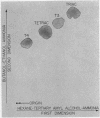Abstract
Studies of the possibility that thyroxine (T4) is converted to 3.5,3′-triiodo-L-thyronine (T3) in the extrathyroidal tissues in man have been conducted in 13 patients, all but two of whom were athyreotic or hypothyroid, and all of whom were receiving at least physiological replacement doses of synthetic sodium-L-thyroxine.
T3 was found in the sera of all patients, in concentrations ranging between 243 and 680 ng/100 ml (normal range 170-270 ng/100 ml). These concentrations were far in excess of those which would have been expected on the basis of the T3 contamination of the administered T4, as measured by the same technique employed in the analysis of serum. When oral medication was enriched with 125I-labeled T4 for 8 or more days, labeled T3 and tetraiodothyroacetic acid (Tetrac or TA4) were found in the serum to the extent of approximately 2-5% of total radioactivity, as assessed by unidimensional paper chromatography. The same results were obtained with a specially purified lot of radioactive T4 containing less than 0.1% T3 as a contaminant. The identities of the 125I-labeled T3 and TA4 were verified by two-dimensional chromatography as well as by specific patterns of binding in serum. The labeled T3 isolated was bound by albumin and by T4-binding globulin (TBG), but not by T4-binding prealbumin (TBPA): in contrast the labeled TA4 was bound by albumin and TBPA, but not by TBG.
To exclude the possibility that the conversion of T4 to T3 was a peculiarity of the oral route of administration, the sera of two additional patients were obtained 48 hr after 7-day courses of daily intravenous injections of a mixture of stable and 125I-labeled T4. Both stable and labeled T3 were likewise found in these sera.
In contrast to earlier experiments in humans in which 131I-labeled T3 was not definitively demonstrated in serum after a single intravenous injection of 131I-labeled T4, the present findings are taken to provide conclusive evidence of the extrathyroidal conversion of T4 to T3 in man. These results raise once again the question of the extent to which the metabolic effect of T4 is mediated through the peripheral generation of T3.
Full text
PDF
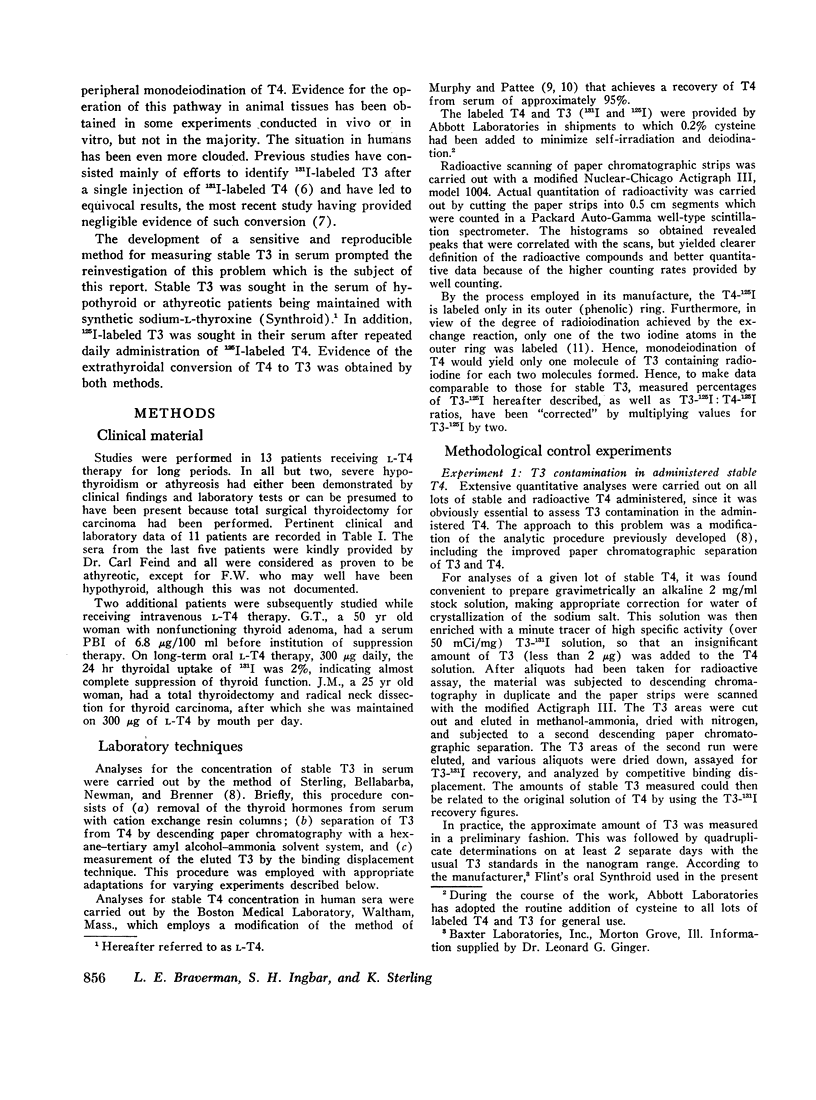

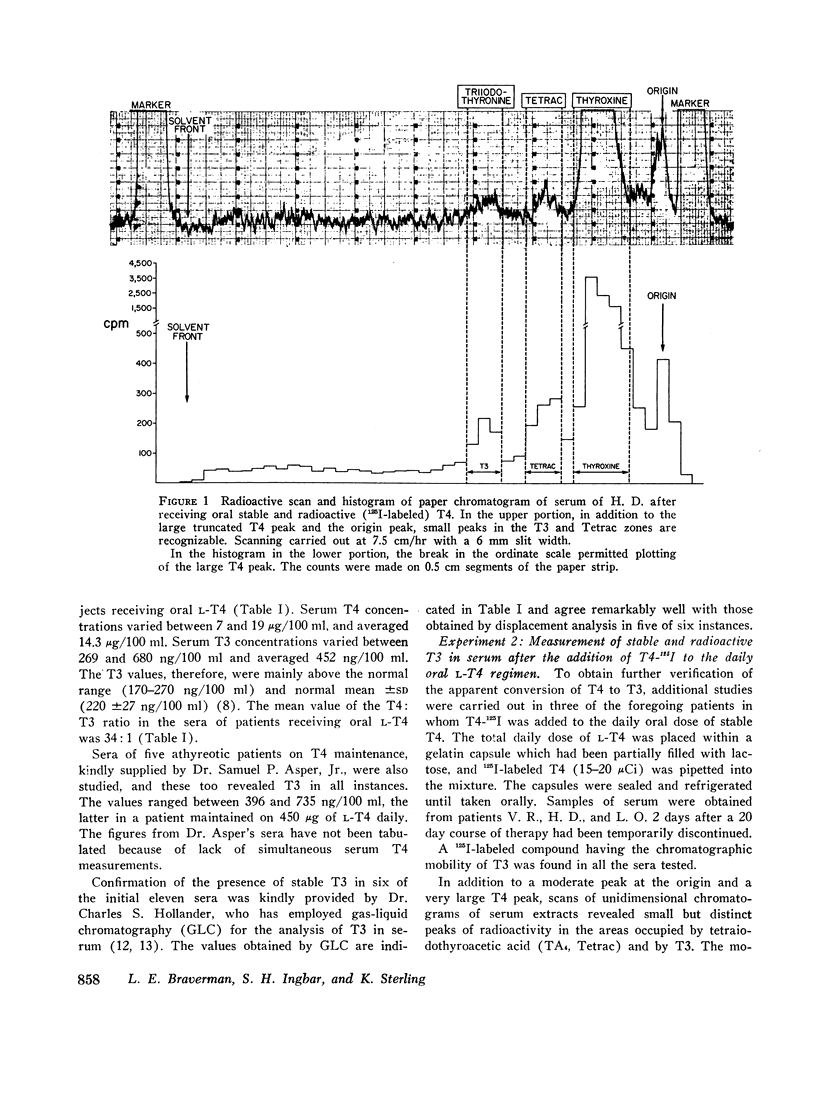
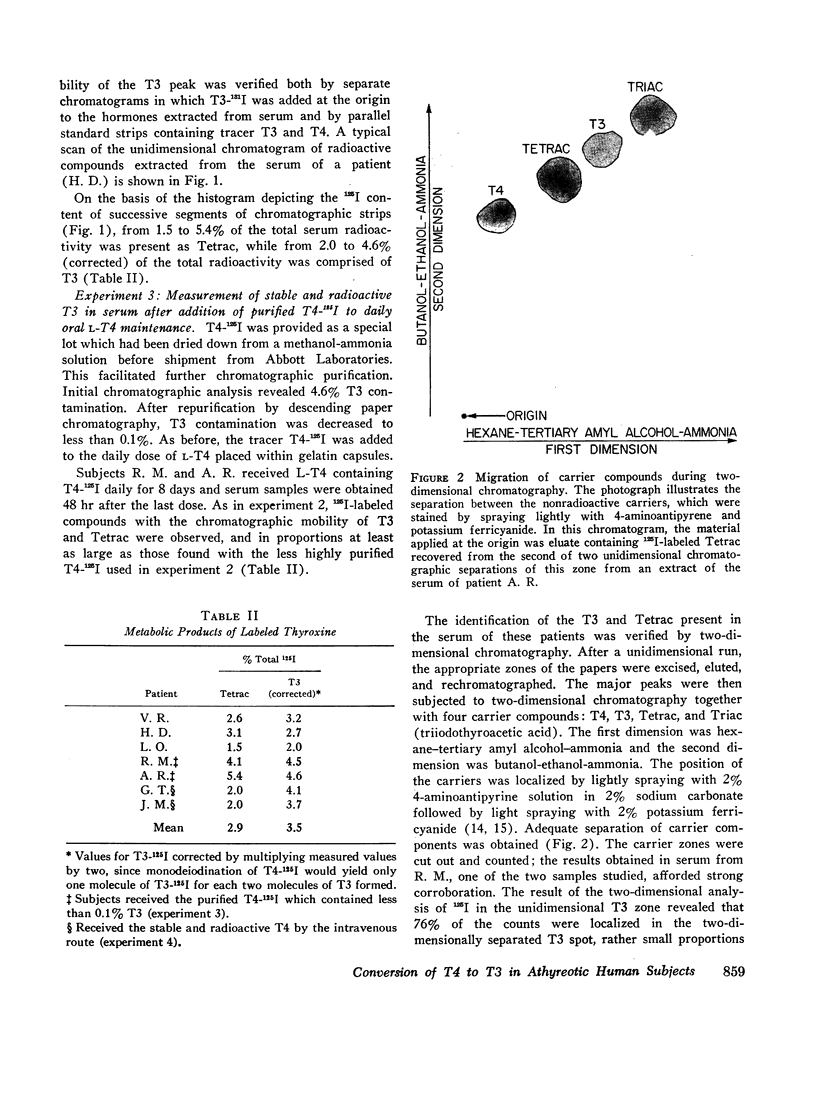
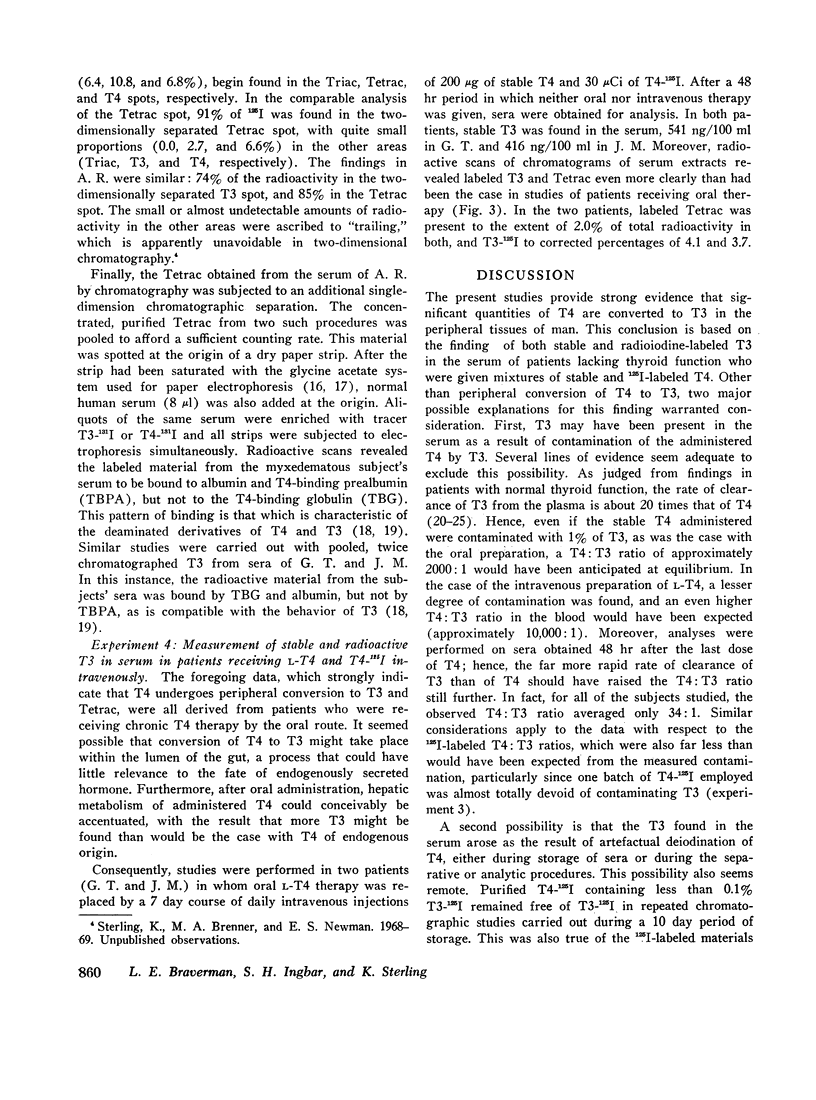
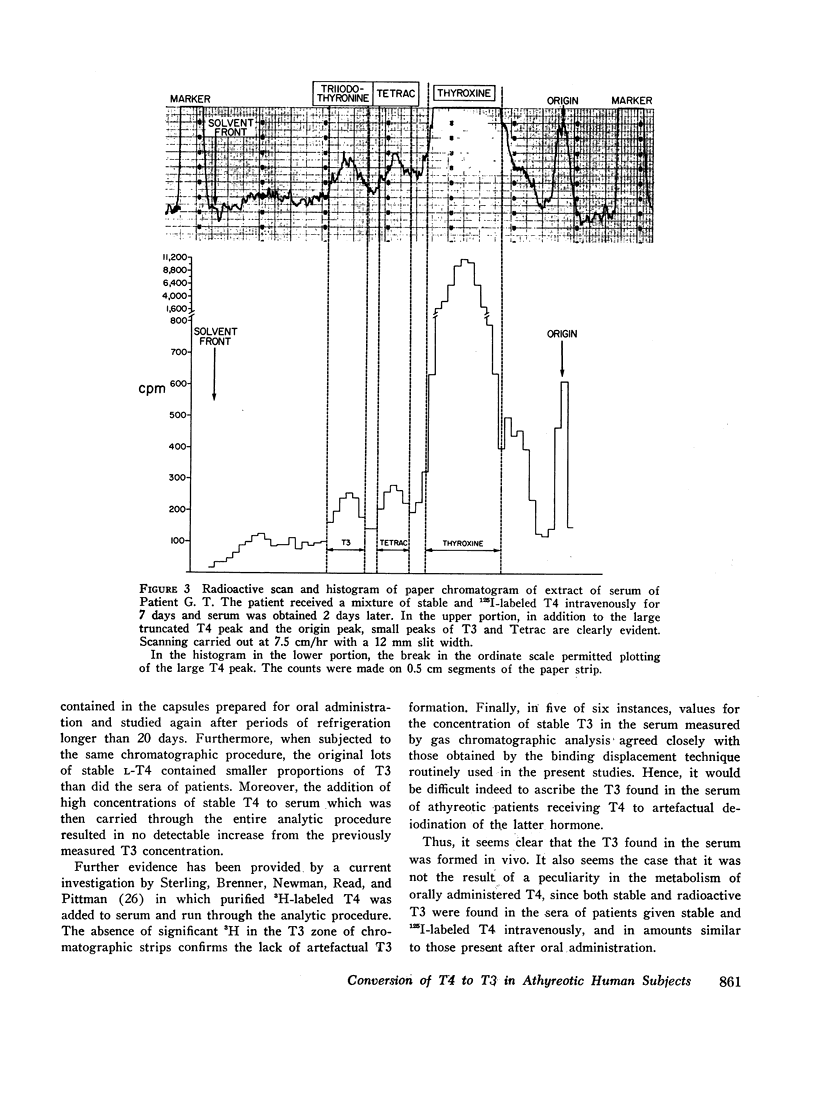

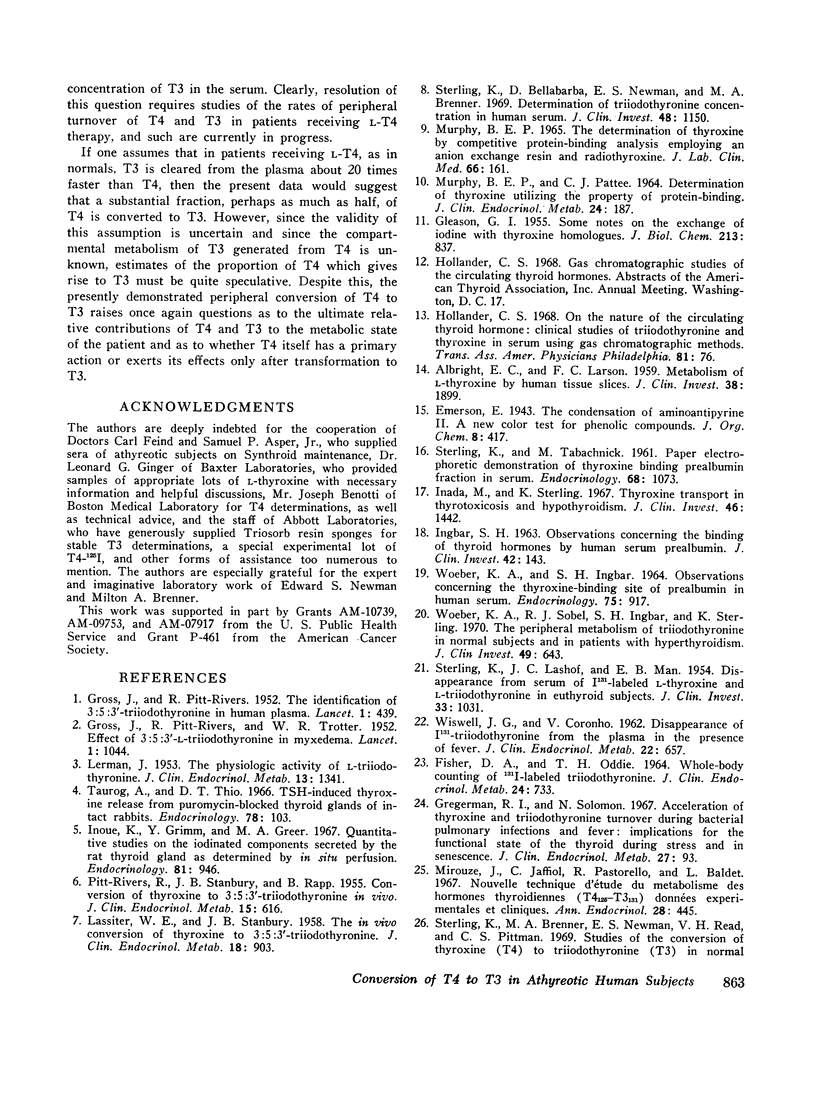
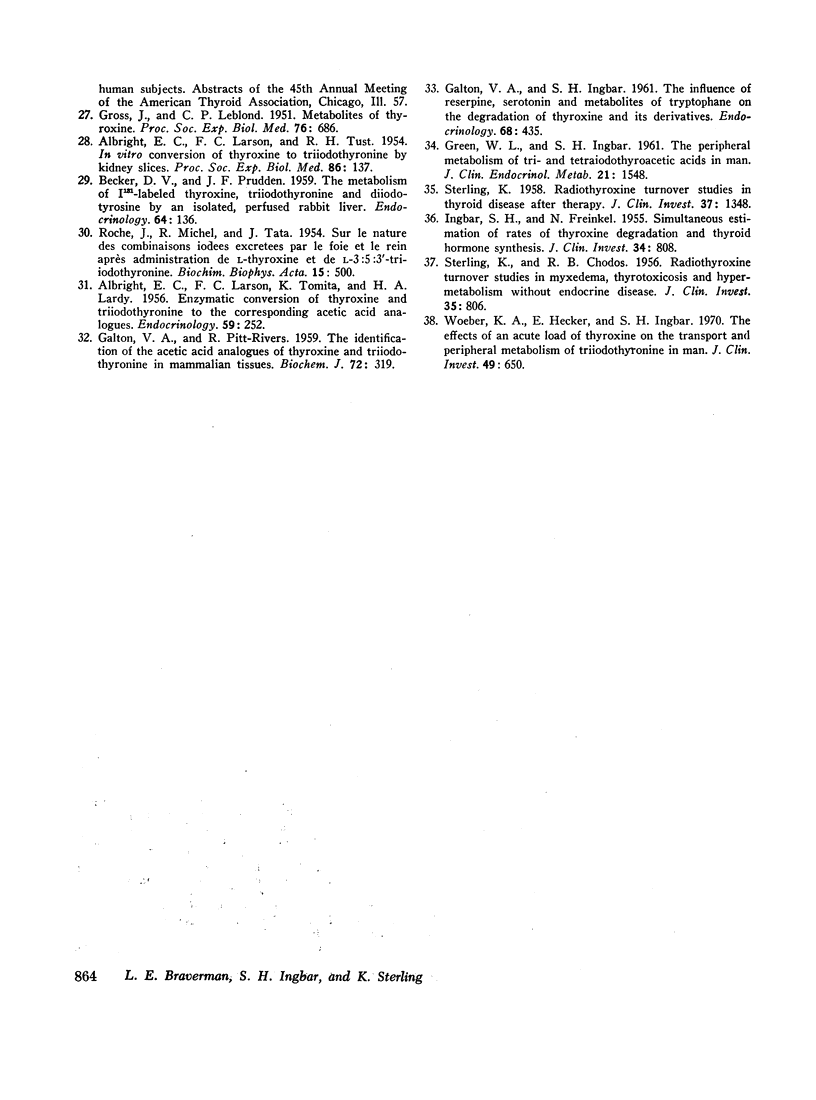
Images in this article
Selected References
These references are in PubMed. This may not be the complete list of references from this article.
- ALBRIGHT E. C., LARDY H. A., LARSON F. C., TOMITA K. Enzymatic conversion of thyroxine and triiodothyronine to the corresponding acetic acid analogues. Endocrinology. 1956 Aug;59(2):252–254. doi: 10.1210/endo-59-2-252. [DOI] [PubMed] [Google Scholar]
- ALBRIGHT E. C., LARSON F. C. Metabolism of L-thyroxine by human tissue slices. J Clin Invest. 1959 Nov;38:1899–1903. doi: 10.1172/JCI103967. [DOI] [PMC free article] [PubMed] [Google Scholar]
- ALBRIGHT E. C., LARSON F. C., TUST R. H. In vitro conversion of thyroxin to triiodothyronine by kidney slices. Proc Soc Exp Biol Med. 1954 May;86(1):137–140. doi: 10.3181/00379727-86-21031. [DOI] [PubMed] [Google Scholar]
- BECKER D. V., PRUDDEN J. F. The metabolism of I 131-labeled thyroxine, triiodothyronine and diiodotyrosine by an isolated perfused rabbit liver. Endocrinology. 1959 Jan;64(1):136–148. doi: 10.1210/endo-64-1-136. [DOI] [PubMed] [Google Scholar]
- FISHER D. A., ODDIE T. H. WHOLE-BODY COUNTING OF 131-I-LABELED TRIIODOTHYRONINE. J Clin Endocrinol Metab. 1964 Aug;24:733–739. doi: 10.1210/jcem-24-8-733. [DOI] [PubMed] [Google Scholar]
- GALTON V. A., INGBAR S. H. The influence of reserpine, serotonin and metabolites of tryptophane on the degradation of thyroxine and its derivatives. Endocrinology. 1961 Mar;68:435–449. doi: 10.1210/endo-68-3-435. [DOI] [PubMed] [Google Scholar]
- GALTON V. A., PITT-RIVERS R. The identification of the acetic acid analogues of thyroxine and tri-iodothyronine in mammalian tissues. Biochem J. 1959 Jun;72(2):319–321. doi: 10.1042/bj0720319. [DOI] [PMC free article] [PubMed] [Google Scholar]
- GLEASON G. I. Some notes on the exchange of iodine with thyroxine homologues. J Biol Chem. 1955 Apr;213(2):837–841. [PubMed] [Google Scholar]
- GREEN W. L., INGBAR S. H. The peripheral metabolism of tri- and tetraiodothyroacetic acids in man. J Clin Endocrinol Metab. 1961 Dec;21:1548–1565. doi: 10.1210/jcem-21-12-1548. [DOI] [PubMed] [Google Scholar]
- GROSS J., LEBLOND C. P. Metabolites of thyroxine. Proc Soc Exp Biol Med. 1951 Apr;76(4):686–689. doi: 10.3181/00379727-76-18595. [DOI] [PubMed] [Google Scholar]
- GROSS J., PITT-RIVERS R., TROTTER W. R. Effect of 3:5:3'-L-triiodothyronine in myxoedema. Lancet. 1952 May 24;1(6717):1044–1045. doi: 10.1016/s0140-6736(52)90695-8. [DOI] [PubMed] [Google Scholar]
- GROSS J., PITT-RIVERS R. The identification of 3:5:3'-L-triiodothyronine in human plasma. Lancet. 1952 Mar 1;1(6705):439–441. doi: 10.1016/s0140-6736(52)91952-1. [DOI] [PubMed] [Google Scholar]
- Gregerman R. I., Solomon N. Acceleration of thyroxine and triiodothyronine turnover during bacterial pulmonary infections and fever: implications for the functional state of the thyroid during stress and in senescence. J Clin Endocrinol Metab. 1967 Jan;27(1):93–105. doi: 10.1210/jcem-27-1-93. [DOI] [PubMed] [Google Scholar]
- Hollander C. S. On the nature of the circulating thyroid hormone: clinical studies of triiodothyronine and thyroxine in serum using gas chromatographic methods. Trans Assoc Am Physicians. 1968;81:76–91. [PubMed] [Google Scholar]
- INGBAR S. H., FREINKEL N. Simultaneous estimation of rates of thyroxine degradation and thyroid hormone synthesis. J Clin Invest. 1955 Jun;34(6):808–819. doi: 10.1172/JCI103136. [DOI] [PMC free article] [PubMed] [Google Scholar]
- INGBAR S. H. Observations concerning the binding of thyroid hormones by human serum prealbumin. J Clin Invest. 1963 Feb;42:143–160. doi: 10.1172/JCI104701. [DOI] [PMC free article] [PubMed] [Google Scholar]
- Inada M., Sterling K. Thyroxine transport in thyrotoxicosis and hypothyroidism. J Clin Invest. 1967 Sep;46(9):1442–1450. doi: 10.1172/JCI105636. [DOI] [PMC free article] [PubMed] [Google Scholar]
- Inoue K., Grimm Y., Greer M. A. Quantitative studies on the iodinated components secreted by the rat thyroid gland as determined by in situ perfusion. Endocrinology. 1967 Nov;81(5):946–964. doi: 10.1210/endo-81-5-946. [DOI] [PubMed] [Google Scholar]
- LASSITER W. R., STANBURY J. B. The in vivo conversion of thyroxine to 3:5:3'triiodothyronine. J Clin Endocrinol Metab. 1958 Aug;18(8):903–906. doi: 10.1210/jcem-18-8-903. [DOI] [PubMed] [Google Scholar]
- LERMAN J. The physiologic activity of l-triiodothyronine. J Clin Endocrinol Metab. 1953 Nov;13(11):1341–1346. doi: 10.1210/jcem-13-11-1341. [DOI] [PubMed] [Google Scholar]
- MURPHY B. E., PATTEE C. J. DETERMINATION OF THYROXINE UTILIZING THE PROPERTY OF PROTEIN-BINDING. J Clin Endocrinol Metab. 1964 Feb;24:187–196. doi: 10.1210/jcem-24-2-187. [DOI] [PubMed] [Google Scholar]
- Mirouze J., Jaffiol C., Pastorello R., Baldet L. Nouvelle technique d'étude du métabolisme des hormones thyroïdiennes (T4-125-T3-131). Ann Endocrinol (Paris) 1967 Jul-Aug;28(4):445–459. [PubMed] [Google Scholar]
- PITT-RIVERS R., STANBURY J. B., RAPP B. Conversion of thyroxine to 3-5-3'-triiodothyronine in vivo. J Clin Endocrinol Metab. 1955 May;15(5):616–620. doi: 10.1210/jcem-15-5-616. [DOI] [PubMed] [Google Scholar]
- ROCHE J., MICHEL R., TATA J. Sur la nature des combinaisons iodées excrétées par le foie et le rein après administration de L-thyroxine et de L-3:5:3'-triiodothyronine. Biochim Biophys Acta. 1954 Dec;15(4):500–507. doi: 10.1016/0006-3002(54)90007-4. [DOI] [PubMed] [Google Scholar]
- STERLING K., CHODOS R. B. Radiothyroxine turnover studies in myxedema, thyrotoxicosis, and hypermetabolism without endocrine disease. J Clin Invest. 1956 Jul;35(7):806–813. doi: 10.1172/JCI103333. [DOI] [PMC free article] [PubMed] [Google Scholar]
- STERLING K., LASHOF J. C., MAN E. B. Disappearance from serum of I131-labeled l-thyroxine and l-triiodothyronine in euthyroid subjects. J Clin Invest. 1954 Jul;33(7):1031–1035. doi: 10.1172/JCI102970. [DOI] [PMC free article] [PubMed] [Google Scholar]
- STERLING K. Radiothyroxine turnover studies in thyroid disease after therapy. J Clin Invest. 1958 Oct;37(10):1348–1356. doi: 10.1172/JCI103724. [DOI] [PMC free article] [PubMed] [Google Scholar]
- Sterling K., Bellabarba D., Newman E. S., Brenner M. A. Determination of triiodothyronine concentration in human serum. J Clin Invest. 1969 Jun;48(6):1150–1158. doi: 10.1172/JCI106072. [DOI] [PMC free article] [PubMed] [Google Scholar]
- Taurog A., Thio D. T. TSH-induced thyroxine release from puromycin-blocked thyroid glands of intact rabbits. Endocrinology. 1966 Jan;78(1):103–110. doi: 10.1210/endo-78-1-103. [DOI] [PubMed] [Google Scholar]
- WISWELL J. G., CORONHO V. Disappearance of I-131-triiodo-thyronine from the plasma in the presence of fever. J Clin Endocrinol Metab. 1962 Jun;22:657–659. doi: 10.1210/jcem-22-6-657. [DOI] [PubMed] [Google Scholar]
- WOEBER K. A., INGBAR S. H. OBSERVATIONS CONCERNING THE THYROXINE-BINDING SITE OF PREALBUMIN IN HUMAN SERUM. Endocrinology. 1964 Dec;75:917–922. doi: 10.1210/endo-75-6-917. [DOI] [PubMed] [Google Scholar]
- Woeber K. A., Hecker E., Ingbar S. H. The effects of an acute load of thyroxine on the transport and peripheral metabolism of triiodothyronine in man. J Clin Invest. 1970 Apr;49(4):650–654. doi: 10.1172/JCI106276. [DOI] [PMC free article] [PubMed] [Google Scholar]
- Woeber K. A., Sobel R. J., Ingbar S. H., Sterling K. The peripheral metabolism of triiodothyronine in normal subjects and in patients with hyperthyroidism. J Clin Invest. 1970 Apr;49(4):643–649. doi: 10.1172/JCI106275. [DOI] [PMC free article] [PubMed] [Google Scholar]



